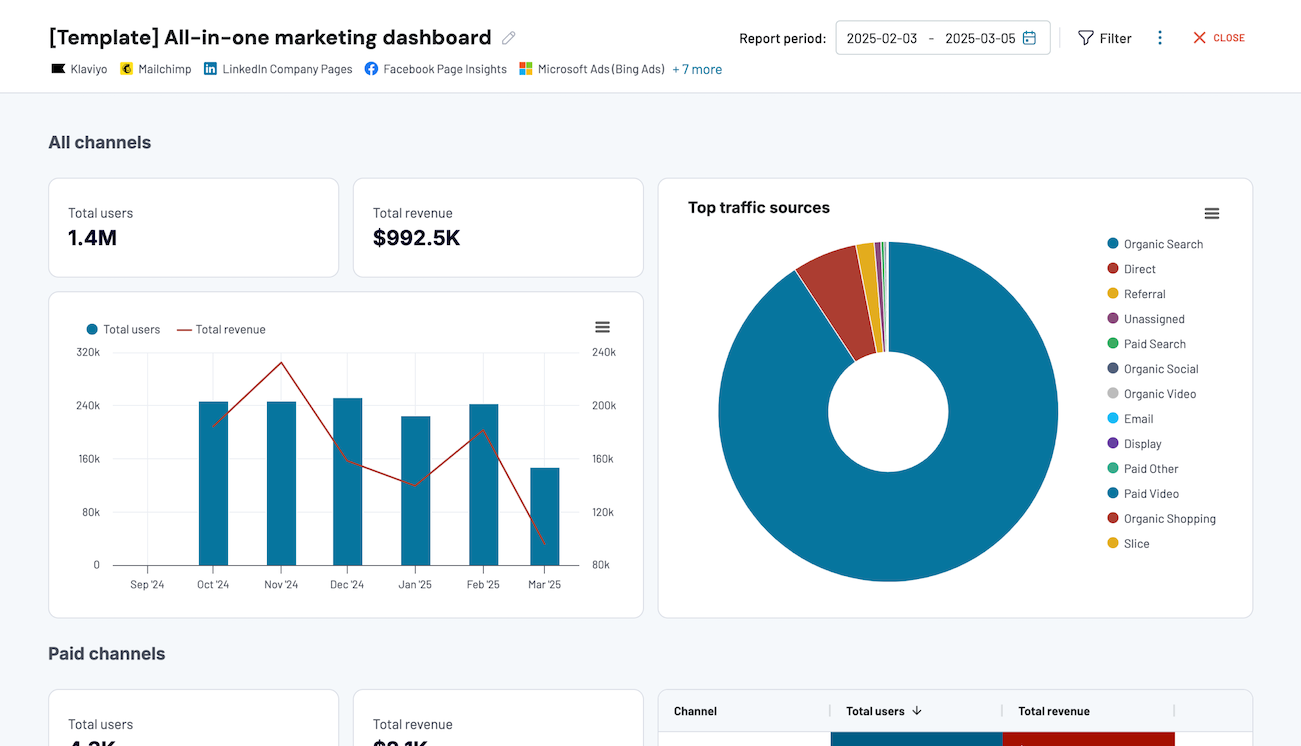Geckoboard is a popular choice for real-time data visualization. Its sleek and simple dashboards help your team monitor performance and make data-driven decisions at a glance.
But it’s by no means the only tool of its kind. When exploring alternatives, you may even question whether it’s truly the best option.
We’ve broken down the most competitive Geckoboard alternatives to help you find the best fit for your business.
The top Geckoboard alternatives at a glance
This article delves into the features, pricing models, and integrations of Geckoboard’s leading alternatives. For a quick overview, the table below summarizes the key details discussed in the following sections.
| Geckoboard | Coupler.io | Whatagraph | Windsor.ai | Porter Metrics | |
|---|---|---|---|---|---|
| Data transformation | ? | ? | ? | ? | ? |
| Built-in dashboards | ? | ? | ? | ? | ? |
| Guided onboarding | ? | ? | ? | ? | ? |
| Free trial | ? | ? | ? | ? | ? |
| Free forever plan | ? | ? | ? | ? | ? |
| G2 rating | 4.3 | 4.8 | 4.5 | 4.6 | 4.6 |
| Affiliate program | ? | ?(25% lifetime recurring commission) | ?(20% recurring commission) | ?(30% lifetime recurring commission) | ?(20% recurring commission) |
| Pricing starts from (monthly) | $60 | $24 | Tailored pricing | $19/month | $12.49/month |
The best Geckoboard alternatives
1. Coupler.io

Coupler.io is a data integration and reporting automation SaaS that transforms data into insightful reports. It enables you to:
- Connect data from over 60 cloud-based sources
- Import and update data on a schedule (near real-time)
- Transform data on the go into a table report
- Visualize your data in ready-to-use dashboard templates
- Load data to spreadsheets, business intelligence tools, or data warehouses
While Geckoboard focuses on data visualization, Coupler.io goes a step further by offering powerful data transformation. What distinguishes it from other Geckoboard alternatives is that it lets you organize and merge data from multiple sources before loading it into a destination.

In comparison, Geckoboard displays data as-is and doesn’t cater to complex data manipulation or perform calculations before it’s shown.
With integration options that include HubSpot, Pipedrive, Xero, QuickBooks, and various Google products, Coupler.io makes it easy to consolidate data from different systems. As a result, you can create multi- and cross-channel reports that will improve your decision-making.
Coupler.io pros
It’s easy to see why over 1 million users, from small businesses to large companies, trust Coupler.io with their data management needs. Here are just a few reasons:
- A versatile tool: Coupler.io provides everything you need in one place. From data integration to automation and reporting, you’ll find it all in this one powerful platform.
- Dashboards and templates: Coupler.io offers over 100 plug-in reports and interactive dashboards to make visualization fast and easy. Users can use some dashboards right in the interface, like this all-in-one marketing dashboard
While others come as templates in BI tools and spreadsheets.
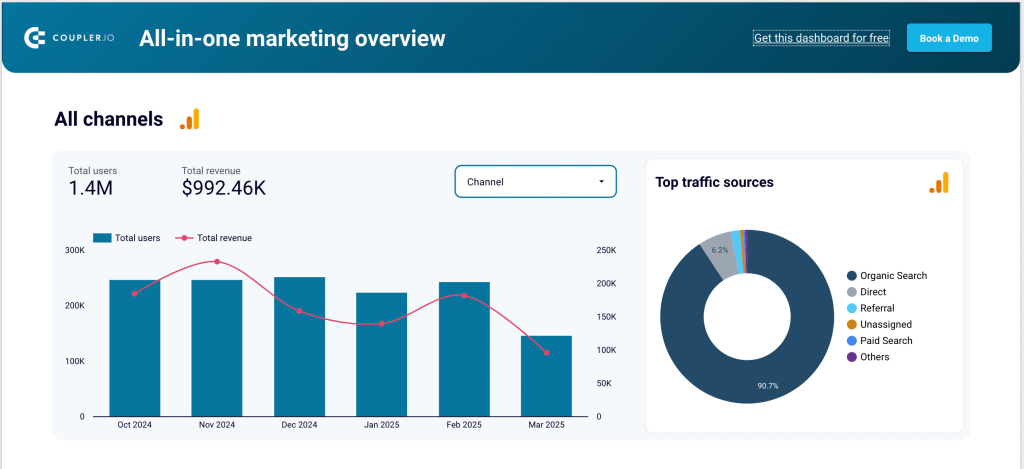
- User-friendly: Coupler.io’s simple no-code setup can be done within minutes, without the need for coding or data analysis. Non-technical users can rely on its intuitive UI.
- Cost-effective for small teams: Coupler.io provides a range of plans designed to suit businesses of all sizes. It also offers both a free trial and a free forever plan.
- Automated reports: There’s no need to manually pull or update data, as Coupler.io handles it for you by automatically refreshing data at your chosen interval (as frequently as every 15 minutes). This saves time and reduces errors.
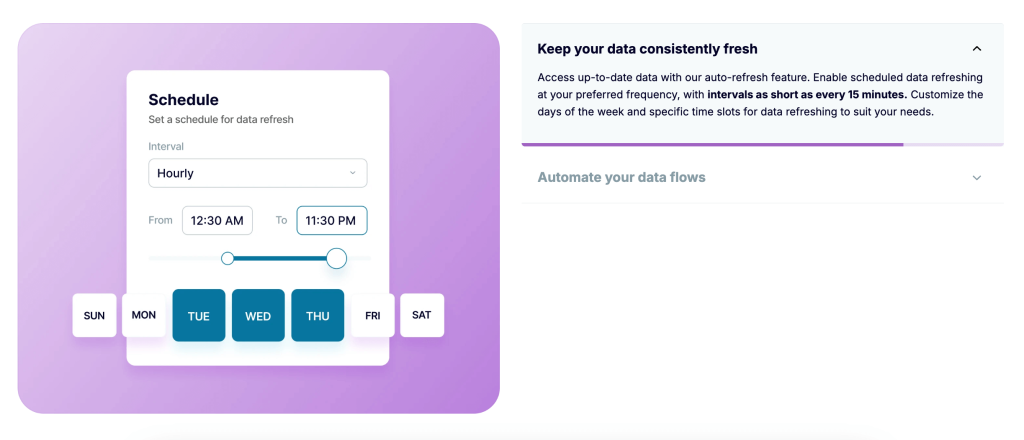
- Scalable for small and large teams: Coupler.io is easily scalable, making it a good fit for both small operations and large enterprises.
Coupler.io cons
- While Coupler.io supports over 60 app sources, the number of available data connections (integrations between data sources and destinations) depends on your pricing plan. Lower-tier plans have access to fewer data connections, which might be restrictive if you need to connect multiple data sources from a variety of platforms.
- Coupler.io only offers 5 native dashboards. By some standards, this can be restrictive. However, it offers over 100 templates for Looker Studio, Google Sheets, Tableau, and Power BI.
Coupler.io pricing
Coupler.io offers five plans, all starting with a free subscription.
| Users | Max. data refresh frequency | Data connections | Starting Price | |
|---|---|---|---|---|
| Free | 1 | Manual | 1 | $0 |
| Personal | 1 | Daily | 5 | $24 |
| Professional | 5 | Daily | 20 | $49 |
| Team | Unlimited | Hourly | 50 | $99 |
| Business | Unlimited | Every 15 minutes | 250 | $249 |
You can start with a 7-day free trial of the Team plan, allowing you to explore the platform before committing.
Coupler.io integrations
Coupler.io lets you automate data flows from over 60 app sources without manual exports or coding. The destinations for the business data include BI tools, such as Power BI and Looker Studio, spreadsheet apps like Google Sheets and Microsoft Excel, and data warehouses like BigQuery and PostgreSQL. The data sources you can extract dara from include:
- Marketing and advertising platforms: Including Facebook Ads, Google Ads, LinkedIn Ads, and Google Analytics. Marketing teams can automate campaign performance tracking and create real-time KPI dashboards without manual data exports.
- CRM and sales tools: Hubspot, Pipedrive, and Salesforce. These integrations mean your sales team can automate pipeline tracking, sync lead data, and create sales dashboards instantly.
- Finance and accounting software: QuickBooks and Xero. Coupler.io lets your finance team automate financial reporting, track expenses, and monitor cash flow trends with real-time data.
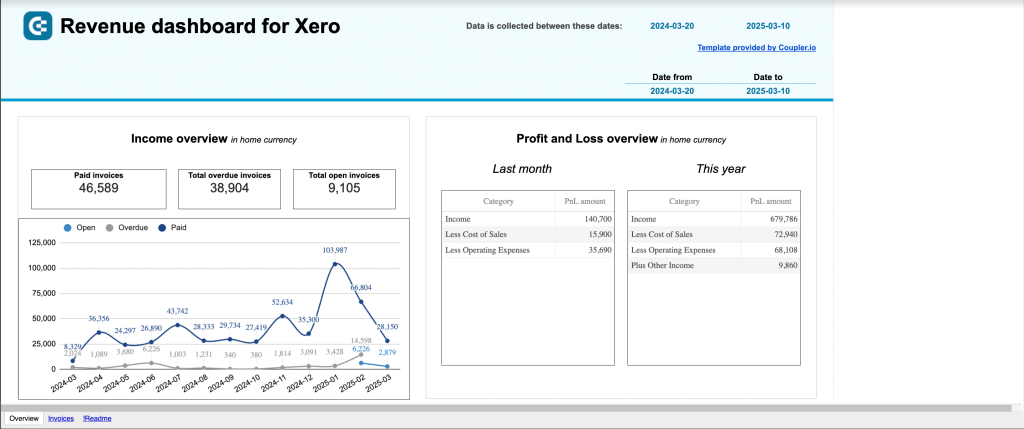
- Project management and collaboration tools: Jira, Trello, and Airtable. This helps your operations and product teams track project progress and consolidate relevant data across tools.
- Social media channels: Instagram Insights, LinkedIn Company Pages, and Facebook Page Insights are just a few examples of social media integrations. You can easily track post performance and automate reports of this data.
- E-commerce platforms: Including Hubspot, Shopify, and WooCommerce. These integrations help you easily manage inventory and automate sales and revenue reports.
- Time-tracking tools: Integrations such as Clockify, Harvest, and TimeTonic help you monitor productivity and automate time-tracking reports.
- Filing and tabulating software: Airtable, Dropbox, OneDrive, Redshift, and CSV. This means you can always ensure files and tables are up-to-date, synchronized, and automated.
2. Whatagraph

Whatagraph is a marketing reporting platform designed primarily for agencies and in-house marketing teams looking to automate their data collection, visualization, and reporting.
Unlike Geckoboard, which focuses on real-time dashboards to visualize key data, Whatagraph is built specifically for marketing analytics.
This makes it a great alternative to Geckoboard if you need a marketing-specific reporting tool, especially one that handles multi-channel campaigns.
Whether you’re an agency managing multiple clients or an in-house marketing team tracking ad performance across different platforms, Whatagraph simplifies data aggregation and real-time reporting.
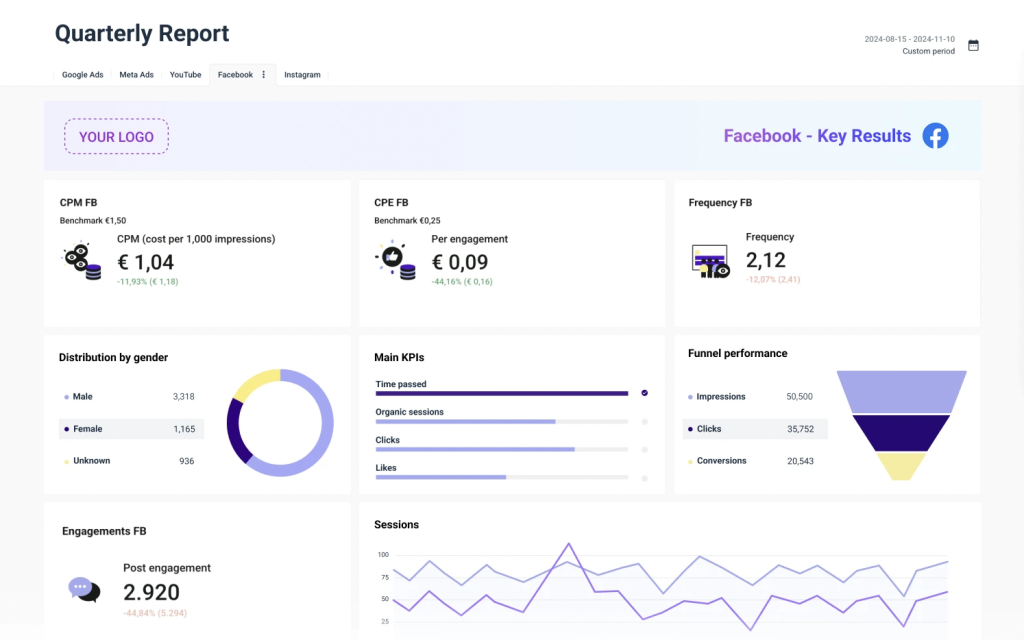
Whatagraph pros
Agencies like Havas Media Group and McCann use Whatagraph for their marketing reporting. Here are a few of the platform’s stand-out advantages:
- 40+ marketing and advertising integrations: Whatagraph integrates with Google Analytics, Facebook Ads, HubSpot, and many more.
- Blends data across platforms: You can merge data from different sources into one report to get a holistic view of your marketing performance.
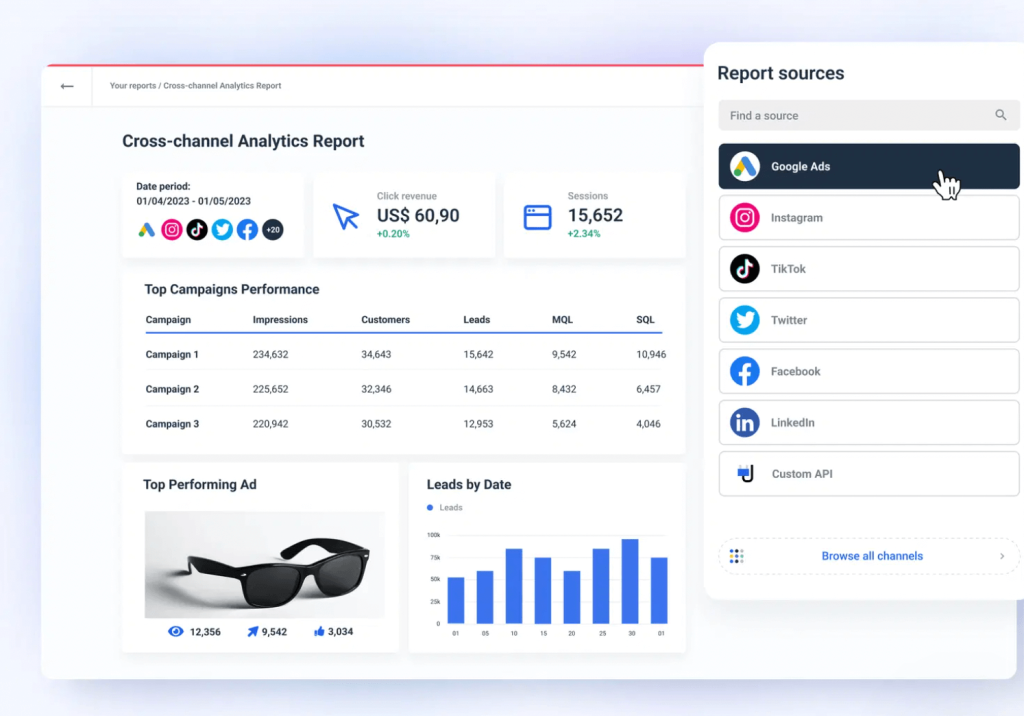
- Customizable dashboards and reports: Whatagraph lets you add widgets, apply filters, and create custom calculations so you can tailor reports to specific KPIs.
- Custom branding: Agencies can add their logo, colors, and domain names to reports for a professional and client-friendly presentation.
- Multi-client management: If you handle multiple clients, you can separate workspaces to keep reports organized for each client.
Whatagraph cons
- Despite its multiple strengths, smaller teams on tight budgets might hesitate at Whatagraph’s presumably high prices. There is no free plan or free trial.
- This Geckoboard alternative is designed for marketing reporting, so it might not be the best fit if you’re looking for a broader BI dashboard.
Whatagraph pricing
Whatagraph’s pricing model is purely customised, with no set payment plans for different tiers.
If you’re interested in migrating to Whatagraph, the best way to understand their pricing is to directly contact a sales representative by filling out the form on their website.
After providing more information about your specific needs during a quick intro call, Whatagraph will provide a quote tailored to your project.
Whatagraph integrations
Whatagraph offers over 50 direct integrations with platforms across different functionalities.
Starting with major advertising platforms, it seamlessly connects with Google Ads, Facebook Ads, LinkedIn Ads, TikTok Ads, and Microsoft (Bing) Ads. These integrations help you track key metrics such as impressions, clicks, CTRs, conversions, and return on ad spend.
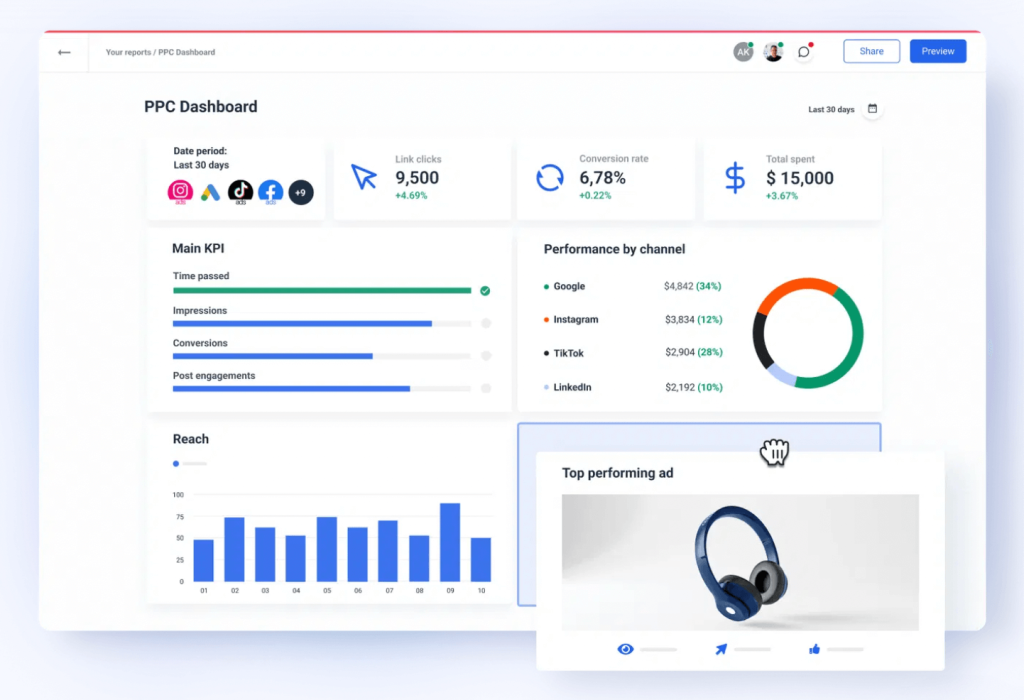
If your focus is on SEO and web analytics, you can integrate Whatagraph with Google Analytics (GA4), Google Search Console, Semrush, and Ahrefs. These connections help monitor organic traffic, keyword rankings, bounce rates, and other key metrics.
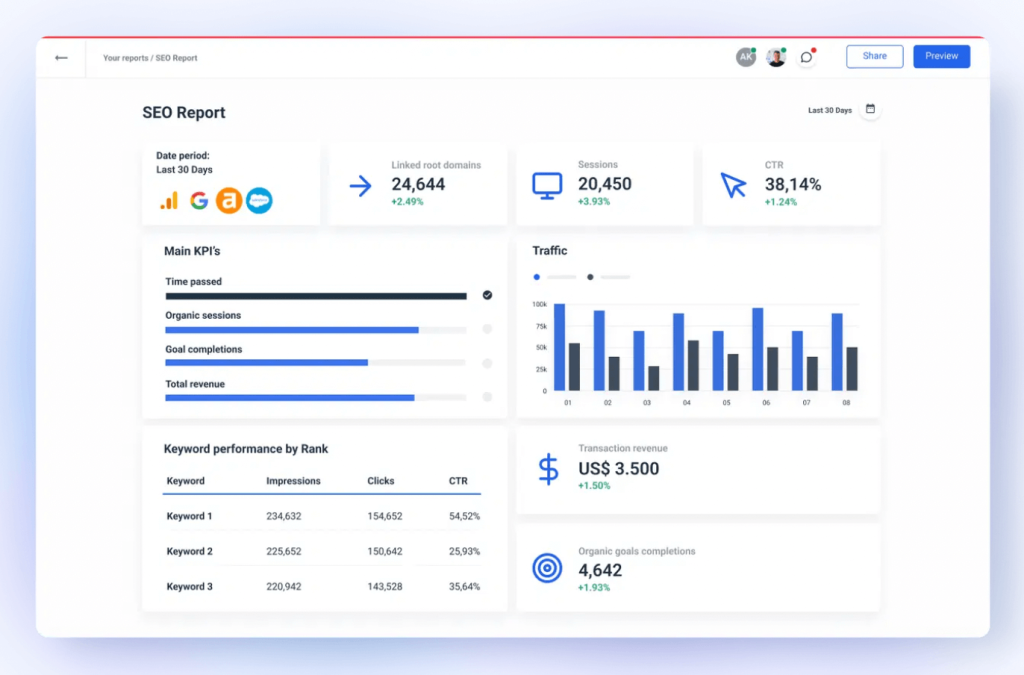
Social media marketers can take advantage of Whatagraph’s connections with Facebook, Instagram, LinkedIn, Twitter (X), YouTube, and TikTok.
Other integrations and data sources include tools across CRM, finance, and project management, making Whatagraph a diverse reporting tool.
3. Windsor.ai

Windsor.ai goes beyond data visualization by providing AI-driven, multi-touch attribution modeling. Essentially, the Geckoboard alternative helps you understand which marketing efforts truly influence conversions so you can allocate spending more effectively.
Both Windsor and Geckoboard are data-driven platforms, but Windsor.ai offers more advanced marketing analytics, attribution modeling, and data transformation capabilities. This makes it a great choice for performance-driven businesses.
Windsor.ai is particularly beneficial if you’re a performance marketer or a digital agency wanting to improve your marketing ROI through attribution modeling and automated reporting.
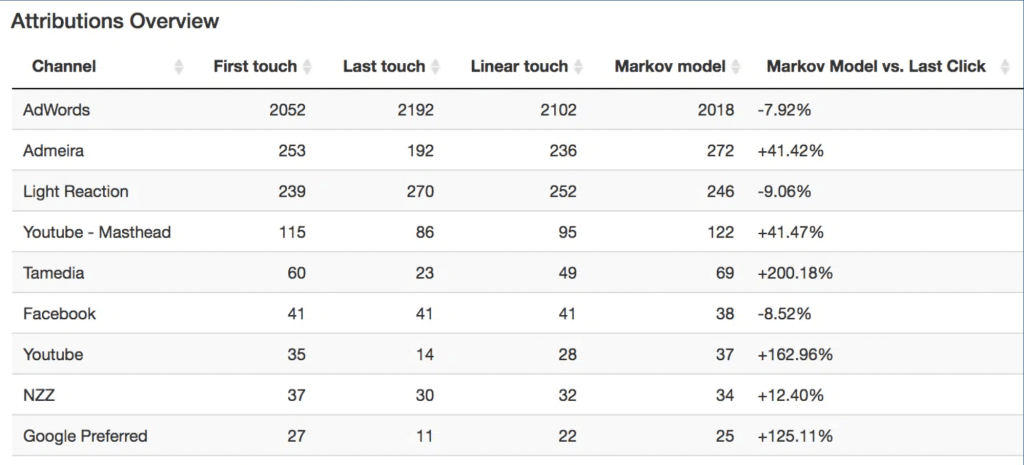
Windsor.ai pros
Over 3,000 data-driven companies use Windsor.ai to manage their data sources, destinations, and syncs from one location. These are just a few of the stand-out features they enjoy:
- AI-driven multi-touch attribution: Windsor automatically analyzes and credits multiple marketing touchpoints, helping you understand how each channel pulls its weight.
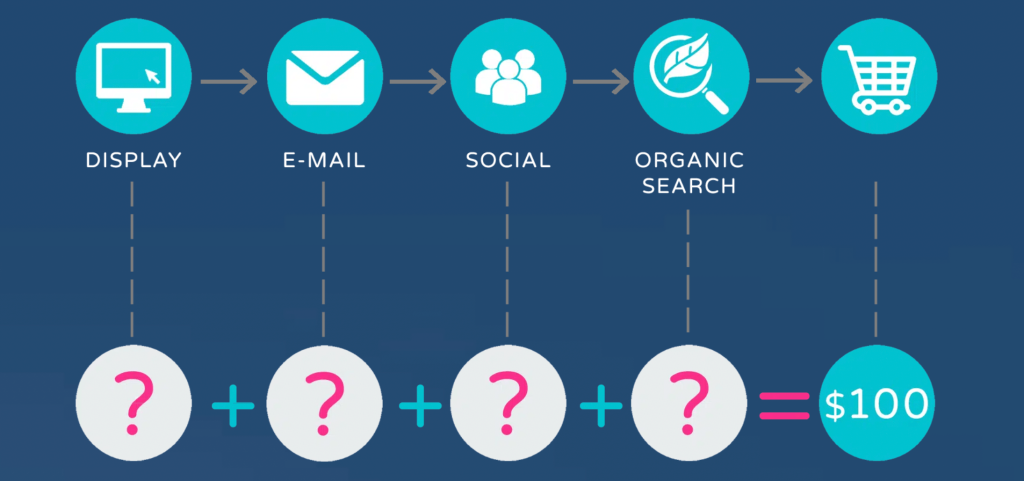
- Advanced data transformation: It offers built-in capabilities for data transformation and enrichment, enabling you to clean, structure, and merge datasets without third-party tools.
- Attribution modeling flexibility: Windsor provides custom attribution models that allow you to adjust how you assign credit across touchpoints.
- Cross-channel reporting: The platform helps you generate unified, cross-channel reports so your teams can analyze marketing performance across various platforms at once.
- Improved marketing ROI: By leveraging AI-powered insights, your organization can optimize their marketing spend, allocate budgets effectively, and improve overall performance.
Windsor.ai cons
- Advanced attribution modeling and data transformation capabilities make Windsor more complex to set up and use. This becomes apparent when you compare it to simpler dashboard tools like Geckoboard.
- Windsor.ai provides some reporting features, but deep data exploration can require exporting your data to BI tools like Looker Studio or Power BI. This adds extra setup steps.
Windsor.ai pricing
Windsor’s pricing model starts with a free trial, which can be extended to a Free Forever plan. However, this plan is limited to just 1 user and 1 data source. Beyond that, you can choose from five paid plans:
- Basic Plan—$19/month billed annually or $23/month billed monthly
- Standard Plan—$99/month billed annually or $118/month billed monthly
- Plus Plan—$249/month billed annually or $299/month billed monthly (most popular option)
- Professional Plan—$499/month billed annually or $598/month billed monthly
- Enterprise Plan—Custom pricing
Each tiered plan offers increased data sources and accounts, as well as more frequent refreshes for more expensive plans.
Windsor.ai integrations
Astonishingly, Windsor offers seamless integrations with over 315 marketing, analytics, and data storage platforms. These connections help you centralize and analyze all your data in one place.
Popular integrations include advertising platforms like Google Ads, Facebook Ads, LinkedIn Ads, and TikTok Ads, helping marketers track and optimize their campaigns with up-to-date data.
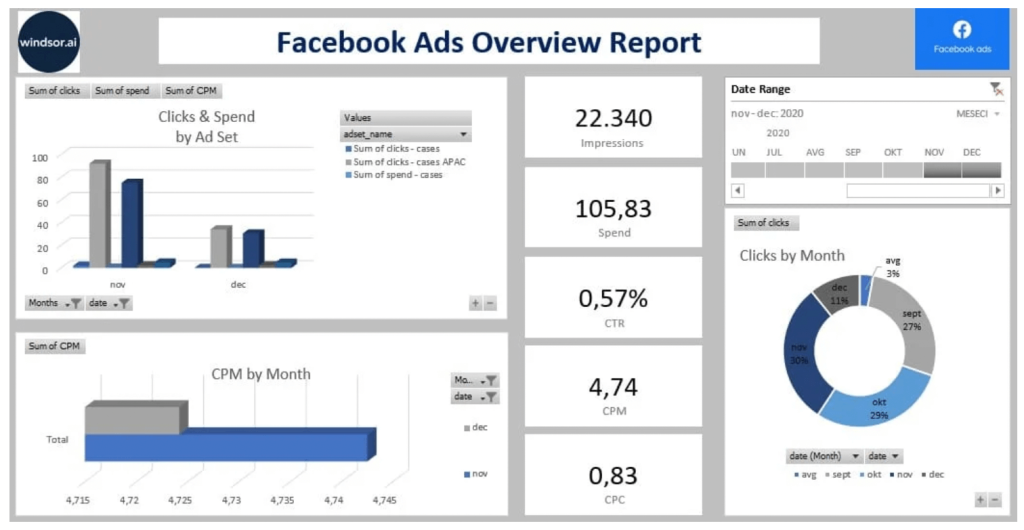
Windsor also allows you to export data directly to Google BigQuery, Snowflake, Power BI, Tableau, and Looker Studio, offering advanced analytics and reporting capabilities.
It supports custom API connections and integrates with Google Sheets and CRMs like HubSpot, giving you a flexible, automated data pipeline.
This level of integration means your team can always work with clean, structured, and up-to-date data without relying on manual data entry or third-party processing tools.
4. Porter Metrics
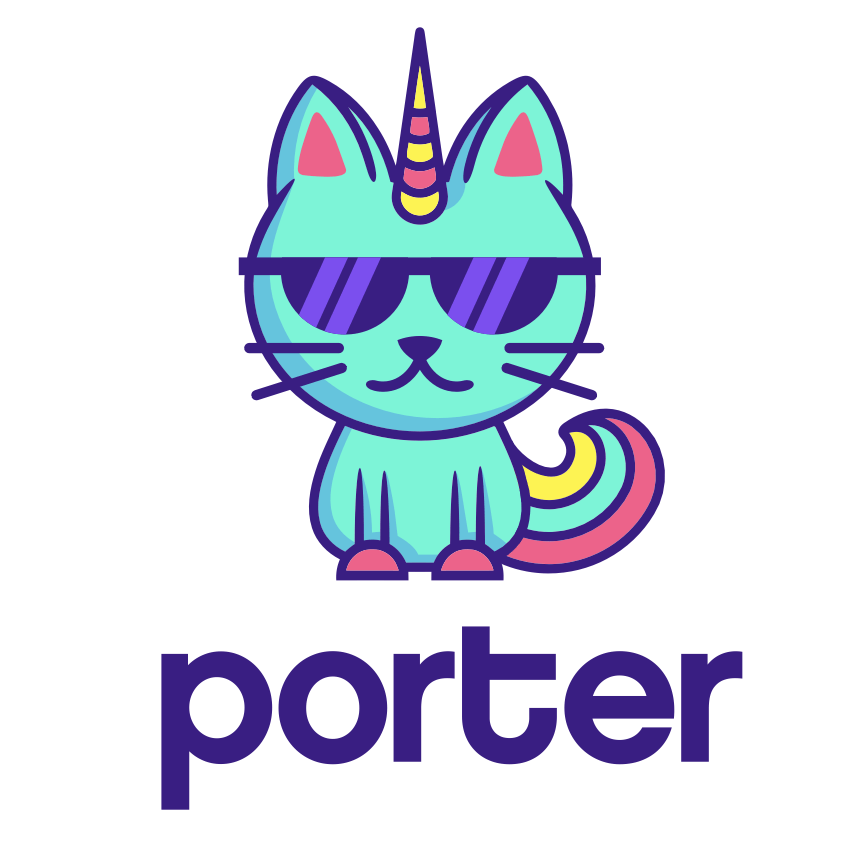
Unlike more complex analytics tools, Porter Metrics focuses on simplicity and ease of use. It allows you to quickly connect your data (from over 90 sources) and generate insightful reports without technical expertise.
Porter integrates with Google Looker Studio, making it a great choice for teams that rely on visual, real-time reporting to track their performance across multiple channels.
With a strong emphasis on plug-and-play integrations, Porter enables users to pull data from platforms like Facebook Ads, Google Ads, Instagram, LinkedIn, and TikTok in just a few clicks, eliminating the need for manual reporting.
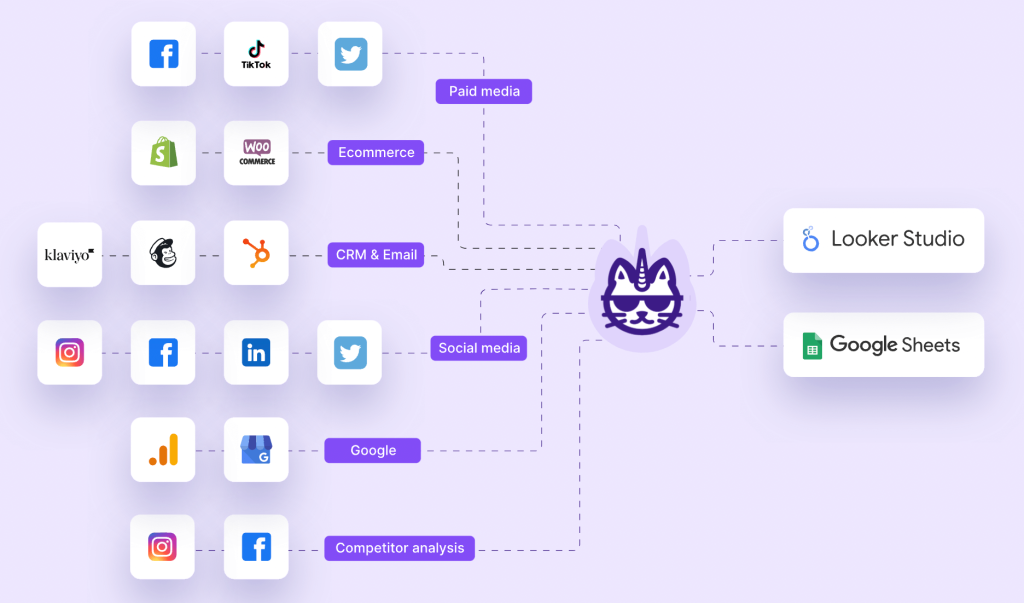
Porter is a strong contender if you’re looking for a quick, user-friendly, and Google Looker Studio-compatible reporting tool.
Porter Metrics pros
With well-known clients like HubSpot, Publicis, and Ogilvy, Porter has proven itself as a dependable tool for data-driven marketing teams. Here’s why:
- Quick, easy setup: Porter’s plug-and-play integrations let you connect your data sources in minutes without needing technical expertise or manual API configurations.
- Seamless, specific destination integration: Porter is specifically designed to work with Google Sheets and Google Looker Studio. You can create customized, real-time reports without third-party visualization tools.
- Pre-built report templates: Just like some of other Geckoboard alternatives, it provides ready-made templates for platforms like Facebook Ads, Google Ads, LinkedIn Ads, and Instagram. You can quickly generate insightful reports with minimal effort.
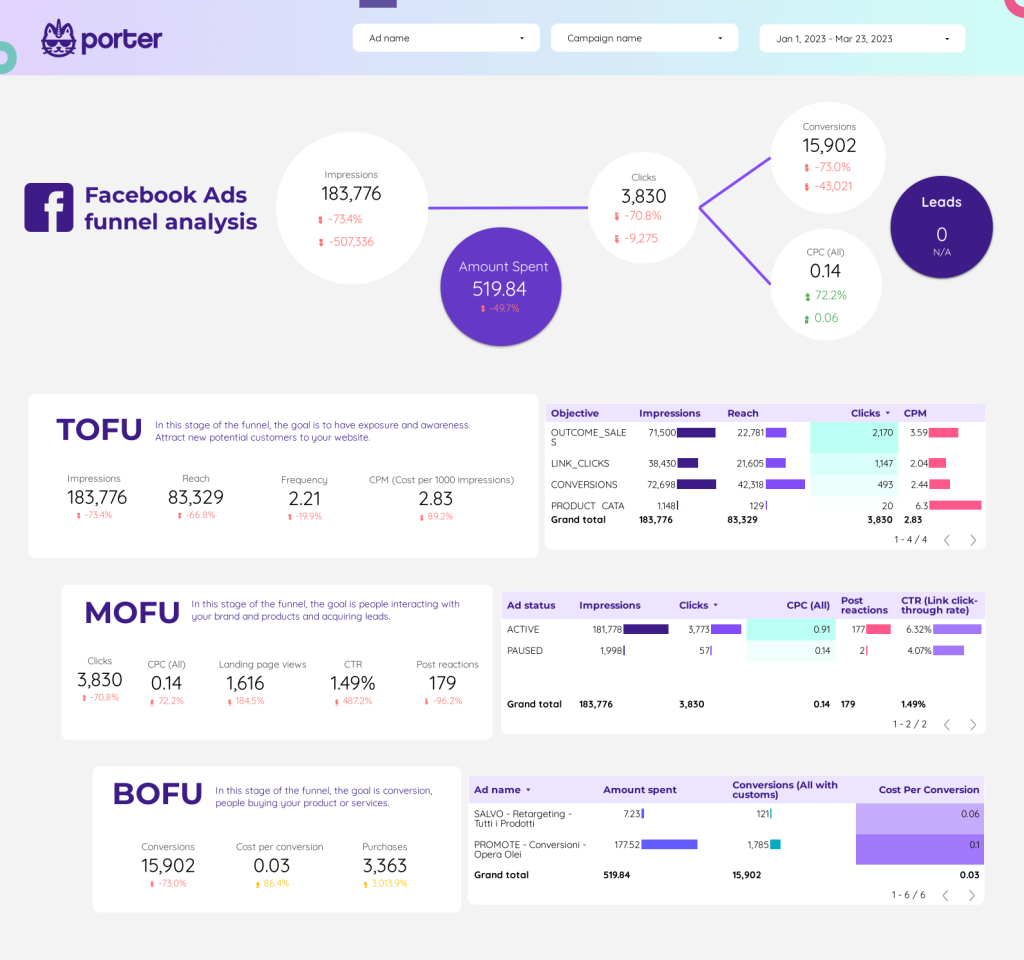
- Affordable pricing: Porter can be considered more budget-friendly compared to other analytics tools, particularly for small to mid-sized marketing teams.
- Robust support and guided onboarding: Porter offers reliable customer support through chat, email, and video calls, as well as guided tutorials to help teams get started quickly.
Porter Metrics cons
- Unlike Geckoboard, which has its own dashboard builder, Porter relies on Google Looker Studio for visualization. You need to be comfortable with Looker Studio’s interface and limitations.
- Porter doesn’t support as many third-party tools as Geckoboard or Windsor.ai, which offer broader data connectivity options.
Porter Metrics pricing
If you want to try Porter, you can choose between four paid plans. Unfortunately, the platform doesn’t offer a free plan:
- Solo Plan—$12.49/month billed annually or $14.99/month billed monthly
- Teams Plan—$33.33/month billed annually or $39.99/month billed monthly
- Agencies Plan—$83.33/month billed annually or $99.99/month billed monthly
- Agencies Pro Plan—$150/month billed annually or $180/month billed monthly
The Teams and Agencies plans also offer two months free, two hours of training on Google Looker Studio and marketing reporting, exclusive Google Looker Studio templates, and a free custom reporting service.
Porter Metrics integrations
Porter focuses on seamless, plug-and-play integrations with key marketing and advertising platforms. This means you can quickly sync data without the need for complex API configurations.
With over 19 data sources and destinations like Google Sheets, Google Looker Studio, and Zapier, it’s an excellent option if you already use Google’s ecosystem for data visualization and reporting.
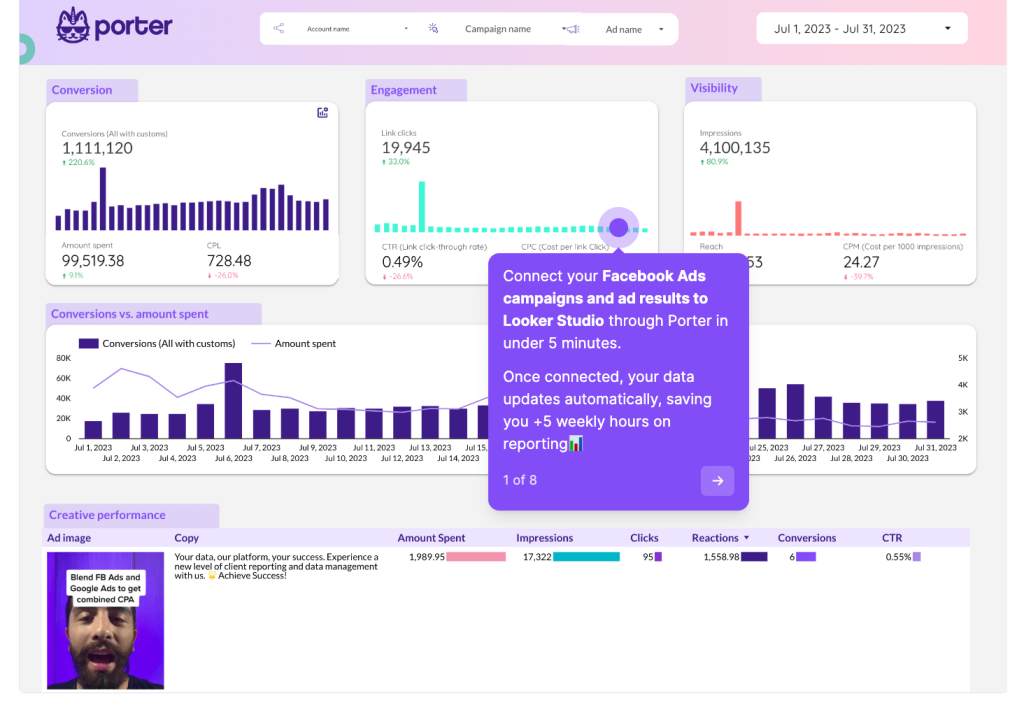
For marketers, its most notable integrations include ad platforms like Facebook Ads, Google Ads, and LinkedIn Ads. These connections help track ad performance and monitor key metrics like click-through rates, conversion rates, and return on ad spend.
Beyond paid media, Porter also integrates with Google Analytics, Google Search Console, and HubSpot. This makes it useful for tracking organic traffic, SEO performance, and inbound marketing efforts.
Geckoboard: A quick refresh
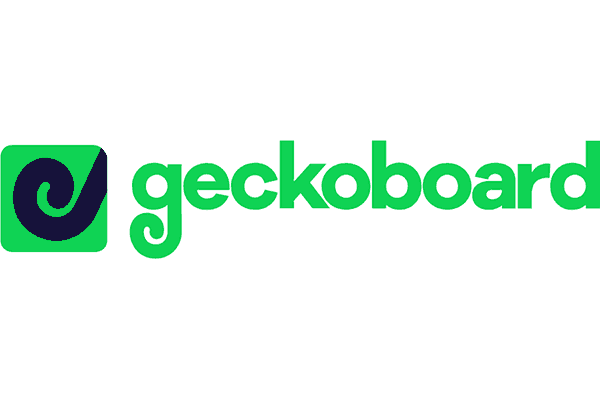
Geckoboard is a real-time business dashboard platform that helps you track and visualize key performance metrics in a clear, appealing format.
You can connect multiple data sources, such as Google Analytics, Salesforce, and social media platforms, and display the most important insights in one centralized dashboard.
One of Geckoboard’s standout features is its customizable dashboards, which allow businesses to create tailored visualizations highlighting the most relevant metrics for their teams.
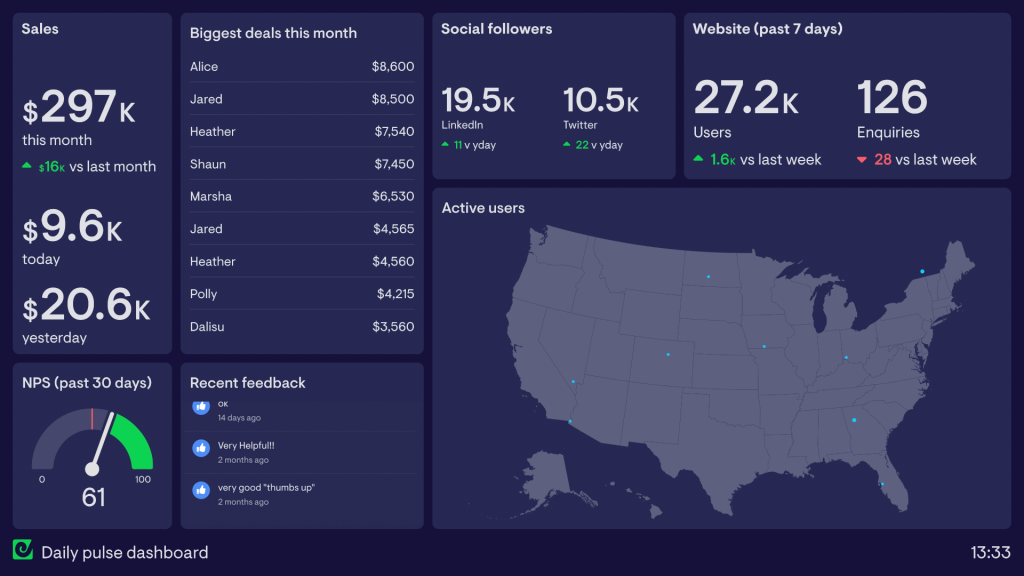
With an emphasis on simplicity and accessibility, Geckoboard is particularly useful if you need quick, at-a-glance reporting without delving into complex analytics.
Geckoboard pros
Geckoboard reviews reflect that the platform works for many teams around the globe. The following features keep this platform competitive:
- A user-friendly interface: Geckoboard is designed for ease of use. You can create custom dashboards with simple drag-and-drop functionality.
- Real-time data updates: No static reports here. Geckoboard provides real-time data visualization, ensuring that your team is always working with the most up-to-date insights.
- Wide range of integrations: Geckoboard connects with over 90 data sources, including Google Analytics, HubSpot, Salesforce, Zendesk, and social media platforms.
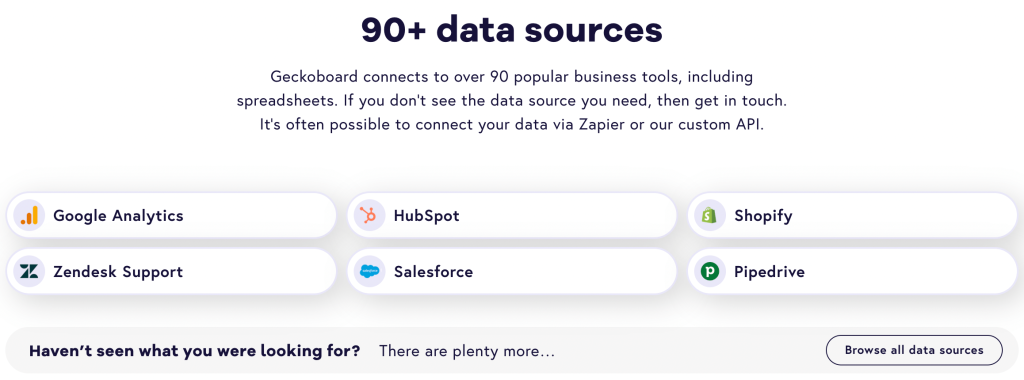
- Customizable and shareable dashboards: Geckoboard lets you tailor your dashboards to focus on specific KPIs. You can also easily share them with teams via live links, TV screens, or email updates.
- Interactive View: With select data sources, Geckoboard dashboards allow you to further investigate why and how metrics change in Interactive View. This helps you identify problem areas more quickly and break down metrics easily.
Geckoboard cons
- While Geckoboard is great at displaying data, it doesn’t offer advanced data manipulation features like blending, transformation, or enrichment.
- According to Geckoboard reviews, it requires manual configuration for certain data updates and alerts. It lacks the advanced automation to match other competitive alternatives in this article.
Geckoboard pricing
Teams from Unilever and Monday.com have found success with Geckoboard, bolstering the platform’s credibility. Those interested have four paid plans to choose from:
- Essential Plan—$60/month billed annually or $75/month billed monthly
- Core Plan—$175/month billed annually or $219/month billed monthly
- Pro Plan—$319/month billed annually or $399/month billed monthly (best value option)
- Enterprise Pro Plan—Custom pricing
Geckoboard doesn’t offer a free forever plan, but all paid plans start with a limited free trial, allowing you to explore the plan’s features before you commit.
Geckoboard integrations
Geckoboard connects with over 90 data sources, making it a versatile tool for tracking business metrics across multiple departments.
It allows you to pull in data from popular platforms such as Google Analytics, Salesforce, HubSpot, and Zendesk, as well as social media channels like Facebook, Twitter, and Instagram.
The platform also integrates with data warehouse tools like Google Sheets and MySQL, providing the flexibility to bring in custom data for more specialized reporting. This is ideal if you need to combine manual inputs with automated data from other platforms.
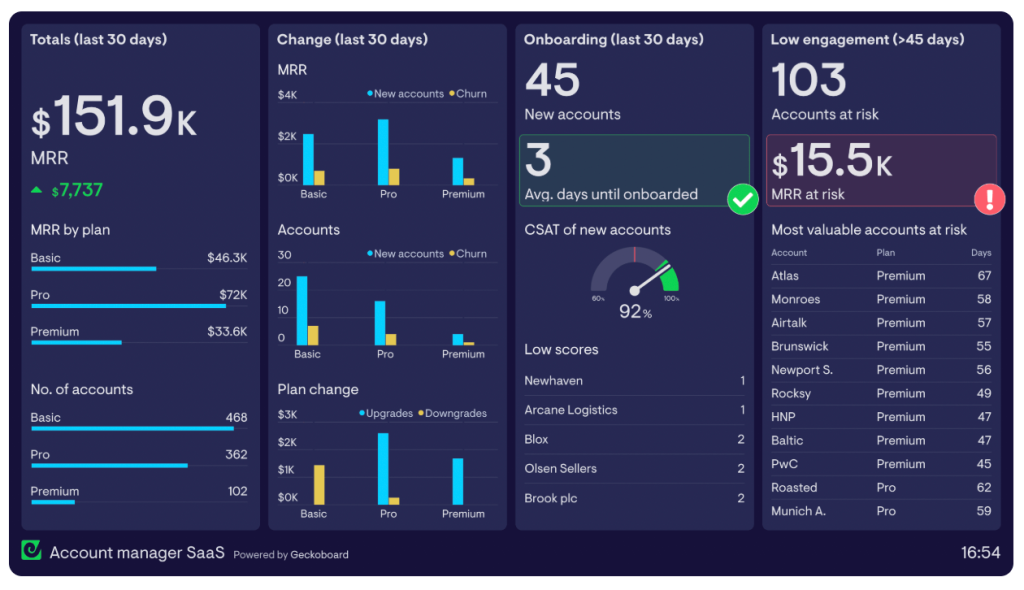
However, compared to alternatives, such as Windsor.ai or Coupler.io, Geckoboard’s integrations focus more on visualization rather than data transformation or processing.
While it’s great at displaying information, you may find its integrations limited if you’re looking for more complex data blending or manipulation.
Why would you need a Geckoboard alternative?
While Geckoboard is an excellent tool for creating real-time dashboards and visualizing key metrics, it may not meet the needs of every organization.
For one thing, it lacks the advanced data transformation and manipulation features offered by Geckoboard alternatives like Coupler.io or Windsor.ai. If you require more in-depth data blending, enrichment, or custom processing, you might want to explore an alternative to Geckoboard.
Porter Metrics and Windsor.ai offer more robust capabilities for ad performance tracking, multi-touch attribution, and real-time marketing insights. If your primary goal is to create detailed reports on marketing campaign performance, Geckoboard may not meet all your needs.
Geckoboard’s out-of-the-box templates might feel restrictive if you’re looking for more customization and flexibility in your dashboards.
The alternatives explored in this article offer deeper functionality and flexibility to help you make data-driven decisions. The right choice ultimately depends on your team’s needs and the complexity of the data you work with.
One alternative to Geckoboard that stands out
Geckoboard is a great tool for quick, at-a-glance reporting. However, it may not be the best fit for organizations with more advanced reporting or data manipulation needs.
If your team needs a robust, automated reporting solution with seamless data integration and transformation capabilities, Coupler.io ticks all the boxes.
With its easy ETL setup, powerful integration options, and automated data workflows, Coupler.io can become a perfect Geckoboard alternative to automate your reporting process and give you the insights you need.
Try Coupler.io today to explore its features and benefits for yourself.
Automate reporting with Coupler.io
Get started for free
